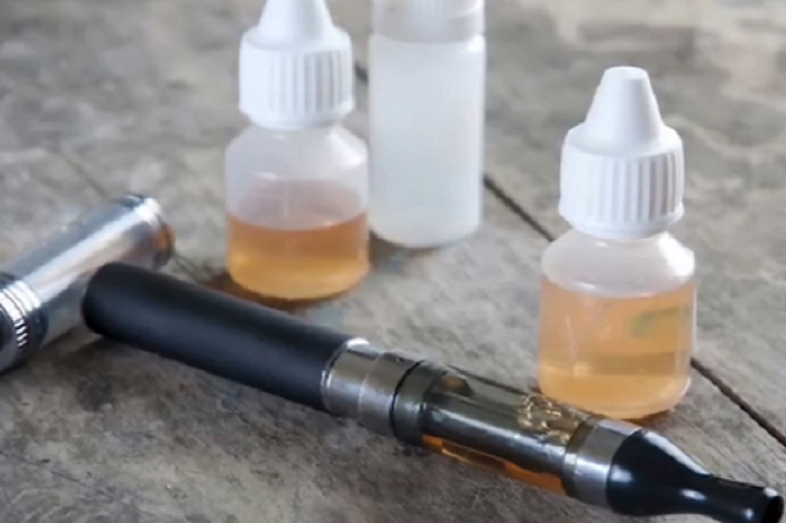

The Centers for Disease Control and Prevention has reported more than 2,500 hospitalizations related to vaping usage in 2019. Of the people hospitalized, 54 percent were age 24 or younger. These alarming figures prompted Congress to pass bipartisan legislation this month that would raise the smoking age from 18 to 21. In this installment of Word on the Beat, we break down the unique challenges schools face trying to combat this dangerous trend.
What it means: “Vaping” refers to the use of e-cigarettes, which can contain either flavored nicotine or cannabis oils. They are typically the size of a pen, and some manufacturers, such as the popular brand Juul, have created e-cigarettes that mimic USB drives. Vaping devices were initially marketed as smoking cessation aids and “safer” alternatives to combustible cigarettes. But a sudden spike in lung problems among vapers, and increased usage by young people, have raised alarms. More than 5 million students reported using e-cigarettes in 2019, up from 3.6 million in 2018, according to the 2019 National Youth Tobacco Survey. Nearly one million students have used vaping products daily this year.
Who’s talking about it: Following the news of deaths this summer, political leaders began introducing various proposed bans to address this issue. President Trump stated his intention to ban e-cigarettes, particularly the flavored pods that were considered to be targeting young consumers, but backed down after pressure from lobbyists and political advisors. Michigan, New York, Massachusetts, Rhode Island, Montana, Washington, Oregon and California have all enacted some sort of ban, rule or executive order attempting to address this epidemic. New York, California, and North Carolina all have filed lawsuits against the company JuuL for what they describe as “deceptive and misleading” marketing towards kids.
E-cigarette users have also responded to the concerns, with many saying that while using the products may not be healthy, it is still the safer alternative for people trying to wean themselves off of combustible cigarettes. Consumer Advocates for Smoke-Free Alternatives Association (CASAA) has pushed back against anti-vaping legislation. The group argues that it misleads consumers to describe e-cigarette products to be just as dangerous as cigarettes. CASAA’s chief executive officer, Alex Clark, says the emphasis on the brand JUUL also misrepresents e-cigarette brands as a whole, as many do not market at all to children. CASAA notes on its website that the group has no financial or policy agreements with industry stakeholders, and its current board of 10 has one member who is a retailer.
Clark also said the focus on banning flavors is misguided, as most teens cite their top reason for vaping as socializing, not just because they saw a candy apple cartridge in a window. As one student told The New York Times, “It’s rare to find someone who doesn’t do it,” said Alexis Padilla, 16, a junior. “You can’t go on social media without someone’s videos of them doing it.”
School officials have been struggling with how to police and educate on this issue. Some schools have responded by handing out suspensions for those caught, and, in one instance, removing the doors to the bathroom stalls to deter vaping. Others have tried installing special vape detectors, though still run into issues of faulty technology and pinning down culprits when the alarm goes off and a group of students exits the bathroom.
As the largest manufacturer of e-cigarettes (to the point where “Juuling” has become synonymous with “vaping”), Juul has responded to criticisms of reckless marketing towards youth with an app that verifies a user’s age through facial recognition technology and monitors their vape usage (similar to a FitBit). Users must opt-in to the app, putting the responsibility on teenagers to police their own behavior.
Why it matters: Diana Zuckerman, the president of the National Center for Health Research, said during a recent EWA webinar that the severity of these effects are even more striking when compared to their combustible counterparts. With combustible cigarettes, developing lung cancer generally happens after decades of use. With vaping, she said, patients are hospitalized after months of use.
Researchers are most concerned that the root of the lung illnesses is still unknown. So far, the CDC has determined that the most severe cases have been linked to black market THC-containing e-cigarettes that contain the chemical vitamin E acetate. They are still analyzing whether other chemicals contribute to these reactions. The Food and Drug Administration did not have regulatory control over vape products until 2016. That, coupled with mixed state laws on the legal status of marijuana, means the e-cigarette market is largely unregulated.
Want to know more? Watch EWA’s webinar, “How Schools Are Responding to Vaping Health Concerns,” to hear a principal and the president of the National Center for Health Research discuss how vaping has become a growing public health concern in schools.
Miles O’Brien at PBS Newshour dissects why researchers haven’t been able to get to the root of what exactly in vapes has been causing the illnesses and deaths.
EWA members Denisa Superville and Arianna Prothero at Education Week look at different techniques educators have used to try and dissuade teens from using these products.
At the Seattle Times, EWA member Dahlia Bazzaz ties Washington state’s dwindling funding for a drug intervention program in schools to their struggles trying to educate students about the dangers of vaping.


